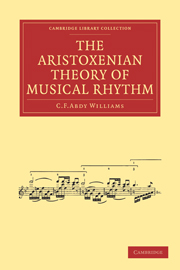Book contents
- Frontmatter
- PREFACE
- Contents
- MUSICAL ILLUSTRATIONS
- INTRODUCTION
- CHAPTER I
- CHAPTER II
- CHAPTER III
- CHAPTER IV
- CHAPTER V
- CHAPTER VI
- CHAPTER VII
- CHAPTER VIII
- CHAPTER IX
- CHAPTER X
- APPENDIX A Quotations, from original sources, of passages referred to in the text
- APPENDIX B Glossary of Technical Terms
- APPENDIX C Dactylo-epitritic, Logaœdic, and Dochmiac rhythms, and rhythmical modulation. M. Laloy's views
- INDEX
- Frontmatter
- PREFACE
- Contents
- MUSICAL ILLUSTRATIONS
- INTRODUCTION
- CHAPTER I
- CHAPTER II
- CHAPTER III
- CHAPTER IV
- CHAPTER V
- CHAPTER VI
- CHAPTER VII
- CHAPTER VIII
- CHAPTER IX
- CHAPTER X
- APPENDIX A Quotations, from original sources, of passages referred to in the text
- APPENDIX B Glossary of Technical Terms
- APPENDIX C Dactylo-epitritic, Logaœdic, and Dochmiac rhythms, and rhythmical modulation. M. Laloy's views
- INDEX
Summary
“What is rhythm?” asks Baccheios the Elder, in his catechism (Appendix A, I), and answers the question thus. “A measuring of time by means of some kind of movement. According to Phaedrus, rhythm is some measured thesis of syllables, placed together in certain ways. According to Aristoxenus, it is time, divided by any of those things that are capable of being rhythmed. According to Nicomachus, it is a well-marked movement of ‘times.’ According to Leophantus, it is a putting together of ‘times’ in due proportion, considered with regard to symmetry amongst them. According to Didymus, it is a schematic arrangement of sounds. Sound, schematised in some way, produces rhythm, and rhythm arises in speech, or melody, or movements of the body.”
Movement is essential to rhythm. The ancients, who liked to systematise everything, divided the arts into two triads, of which the first consists of those which depend on repose and space, that is to say, Architecture, Painting, and Sculpture, while the second triad contains those which employ movement, namely, Music, Poetry, and the Dance. In the first triad the element of form produces symmetry, in the second, rhythm. “We delight in rhythm,” says the author of the XIXth Problem, “because it has a recognisable and regulated number, and moves us regularly. The regular movement is more easy to us than the unregulated, since it is more in accordance with nature.”
- Type
- Chapter
- Information
- The Aristoxenian Theory of Musical Rhythm , pp. 24 - 33Publisher: Cambridge University PressPrint publication year: 2009First published in: 1911



